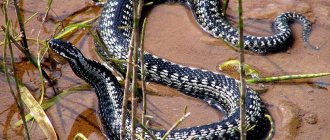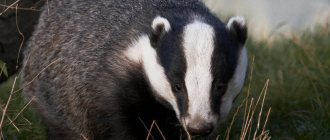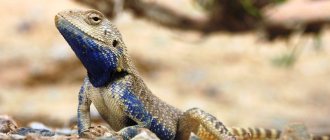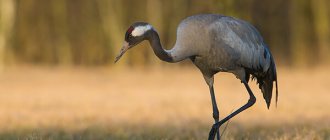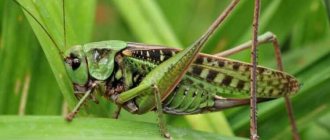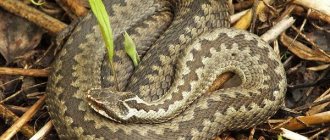- Wild animals
- >>
- Reptiles
The steppe viper , at first glance, differs little from its relatives. But the snake has a number of features that set it apart from other vipers. In addition, the steppe viper is often found in various parts of the CIS countries, so it is important to understand what this poisonous snake looks like and what the characteristics of its behavior are.
Description of the steppe viper
The length of the reptile's body with head is on average 45-48 cm; the known record for this species is 70 cm. Females are slightly larger than males.
On top, the snake is brownish-gray in color with the same zigzag stripe along the ridge as that of an ordinary viper. Sometimes this stripe is broken into separate spots. The head has a symmetrical pattern of dark spots. Completely black individuals (melanists) are very rare among this species.
The steppe viper differs from the common viper primarily in its smaller size. In addition, the upper side of its head sharply turns into the side, forming a pronounced rib; as a result, the lateral edge of its muzzle is pointed (in the common one it is rounded) and slightly raised above its upper part.
copperhead
The copperhead is a non-venomous snake, widespread throughout the peninsula. The skin of a snake can have several shades: from golden to brown (in some individuals the skin color reaches an almost black shade). Sexual dimorphism differs: females are larger and have a predominantly brown color.
A distinctive feature is two black stripes that originate from the very tip of the muzzle and pass through the center of the eye. There are several vertical black spots on the sides. The mouth contains rows of teeth, but absolutely no poisonous glands or ducts.
Copperheads love warmth, and therefore you can accidentally meet the reptile in the sun, in thickets of bushes, or on the stumps of felled trees. Representatives of this species are excellent swimmers, but avoid water. A copperhead can bite a person only in cases of extreme danger or fear.
What does it look like
To get to know each other better, we invite you to look at the photo and read a brief description of the snake’s appearance. Did you know? Vipers catch prey with lightning speed. It takes her less than a second to rush at her, inject poison and retreat back. The steppe viper is a species of real vipers of the viper family: its body reaches an average length of 55 cm, its tail is 7–9 cm. In some regions, individuals with a body length of 63 cm are found. Females are usually larger than males; the average weight of adult snakes is 15–17 kg; Representatives of this species have an elongated head with raised edges of the muzzle.
On top, in front of the frontal shield, there are small, irregularly shaped scutes; the main color of the steppe viper is gray with brown; the back is lighter; A black or dark brown zigzag stripe runs along the ridge. Can be depicted dotted, in the form of spots; the sides of the body are dotted with blurry dark spots; there is a drawing on top of the head; the belly is painted in light colors with speckles.
Occasionally almost black specimens are found. In appearance, steppe vipers are somewhat similar to water snakes. Their life expectancy in the wild is 7 years. Some sources of information indicate that they can live up to 30. The species is divided into 2 subspecies: western steppe viper (Vipera ursinii); Eastern steppe viper (Vipera renardi). The latter is found only on the territory of the Republic of Moldova. Did you know? Snakes have poor eyesight and no hearing. They track prey by vibrations in the air.
Lifestyle
Adult female, Scotland
Life expectancy can reach 15, and according to some sources, 30 years. However, observations in Sweden indicate that snakes rarely survive beyond two or three years of breeding, which, taking into account the achievement of sexual maturity, gives an age limit of 5-7 years. The viper quickly adapts to any terrain; in the Swiss Alps it rises to 2600 m above sea level. Habitats are more diverse in the northern and eastern parts of the range, where the snake often colonizes peat bogs, heathlands, cleared mixed forests, the banks of various freshwater bodies of water, wet meadows, field edges, shelterbelts, and dunes. In southern Europe, biotopes are mainly limited to wet depressions in mountainous areas. Distribution is uneven depending on the availability of places suitable for wintering. The saddle, as a rule, does not move further than 60-100 meters. The exception is forced migration to a wintering place; in this case, snakes can move away to a distance of up to 2-5 km. Wintering usually occurs from October-November to March-April (depending on the climate), in the north of the range it lasts up to 9 months, for which the snake chooses a depression in the ground (burrows, crevices, etc.) at a depth of up to 2 meters, where the temperature does not drop below +2… +4 °C. If there is a shortage of such places, several hundred individuals may accumulate in one place, and in the spring they crawl to the surface, which creates the impression of great crowding. Subsequently, the snakes crawl away.
In the summer, it sometimes basks in the sun, but mostly hides under old stumps, in crevices, etc. The snake is not aggressive and, when a person approaches, tries to use its camouflage coloring as much as possible, or crawl away. Only in case of unexpected appearance of a person or upon provocation on his part can she try to bite him
This cautious behavior is explained by the fact that it requires a lot of energy to reproduce venom in conditions of changing temperatures.
It feeds mainly on mouse-like rodents, amphibians and lizards, and destroys bird nests located on the ground. The ratio of different feeds may vary depending on availability at a given time and in a given area. Thus, during the observation of vipers in the Netherlands, it was revealed that they prefer grass and sharp-faced frogs, as well as viviparous lizards. In other regions, the diet may be dominated by gray and forest voles, shrews, spindles, chicks of warblers, pipits and buntings. Young snakes catch insects - locusts, beetles, and, less commonly, butterfly caterpillars, ants, slugs and earthworms.
Habitats
The steppe viper is common in Central Asia, Central and Eastern Europe, Northwestern China, Turkey, Iran, Kazakhstan and the Caucasus. This is a fairly common species for the south of Western Siberia and the south of the European part of Russia (in the north its habitat reaches Kazan).
Unlike the common viper, the steppe viper is found in open spaces. It is not for nothing that it received such a name: its favorite habitats are various types of steppes. It also lives on rocky mountain slopes, alpine meadows, sea coasts, riverine forests, ravines, semi-deserts and loose sands. It can also be found in pastures and fields.
In favorable habitats, its population density can be extremely high. For example, in Kazakhstan, in the tea thickets, the number of these snakes can reach up to 45 individuals per 1 hectare, and in the Ciscaucasia - up to 60! In such places you can’t even take a step without bumping into this snake. However, the steppe viper does not have such obvious “snake foci” as are known in the common viper - it is more evenly distributed.
Malicious yellow-bellied snake
Some Crimean snakes, according to official information and reviews, belong to the snake family. They are perceived as exotic, although they are close relatives of the same snakes that we mentioned a little higher in the text. The yellow-bellied or Caspian snake (Dolichophis caspius) is the largest Crimean snake; specimens 2 m long are not uncommon. It has slightly bulging eyes and smooth scales. The body is dark (brown, olive, copper, sometimes black), and the abdomen is bright yellow or orange. There are yellow spots above the eyes.
It climbs trees and bushes well, is often found in vineyards, is not poisonous, but bites often (this distinguishes it from most snakes, which do not attack humans themselves, but only react to irritation). Due to the size of the reptile, the bite can be quite painful. But it is no more dangerous than a household knife cut. The wound just needs to be treated with disinfectants and closed to prevent infection. It will heal completely in a couple of days. A sudden attack is very frightening for many, so you should consider whether to take small children on walks through vineyards or dense bush.
Lifestyle and nutrition of the steppe viper
This snake prefers dry places, such as slopes covered with bushes, mountain and lowland steppes. It is also found in alpine meadows and ravines. In the mountains, this viper is found at altitudes of up to 2600 meters. In all of the listed places in its range, the steppe viper is not a common inhabitant.
On land, the viper moves slowly, but it swims well and can climb low trees.
There are places where the population density is up to 20–40 individuals per hectare. In the Saratov region, the density ranges from 4 to 9 individuals per 1 hectare, and in the north of the Lower Volga region there are only 2 to 5 individuals. The density of individuals is especially high in the steppes.
The steppe viper is active from the third ten days of March until October. Hibernation ends when the ambient temperature rises above 6 °C on average. In spring, while it is not very hot, this snake can be found even during the day. With the onset of summer, it appears on the surface only in the evening and morning hours. The steppe viper is an excellent swimmer. It moves rather slowly on a hard surface. Good at climbing trees. This snake spends the winter alone, hiding in empty rodent burrows, cracks in the ground, and between stones. It spends almost the entire cold season of the year in hibernation, but on warm winter days it can crawl to the surface and bask on the rocks.
Vipers are predators. They feed on small birds, spiders, and lizards.
The snake feeds on eggs and chicks, destroying bird nests. Its regular diet also includes rodents and lizards. The viper also does not disdain insects such as spiders, crickets, locusts and grasshoppers. At the beginning of spring, the diet is dominated by small lizards, but towards the end the balance shifts in favor of rodents and insects (mainly grasshoppers and locusts). Food in the viper's stomach is digested within 48 - 96 hours.
Lifestyle
Adult female, Scotland
Life expectancy can reach 15, and according to some sources, 30 years. However, observations in Sweden indicate that snakes rarely survive beyond two or three years of breeding, which, taking into account the achievement of sexual maturity, gives an age limit of 5-7 years. The viper quickly adapts to any terrain; in the Swiss Alps it rises to 2600 m above sea level. Habitats are more diverse in the northern and eastern parts of the range, where the snake often colonizes peat bogs, heathlands, cleared mixed forests, the banks of various freshwater bodies of water, wet meadows, field edges, shelterbelts, and dunes. In southern Europe, biotopes are mainly limited to wet depressions in mountainous areas. Distribution is uneven depending on the availability of places suitable for wintering. The saddle, as a rule, does not move further than 60-100 meters. The exception is forced migration to a wintering place; in this case, snakes can move away to a distance of up to 2-5 km. Wintering usually occurs from October-November to March-April (depending on the climate), in the north of the range it lasts up to 9 months, for which the snake chooses a depression in the ground (burrows, crevices, etc.) at a depth of up to 2 meters, where the temperature does not drop below +2… +4 °C. If there is a shortage of such places, several hundred individuals may accumulate in one place, and in the spring they crawl to the surface, which creates the impression of great crowding. Subsequently, the snakes crawl away.
In the summer, it sometimes basks in the sun, but mostly hides under old stumps, in crevices, etc. The snake is not aggressive and, when a person approaches, tries to use its camouflage coloring as much as possible, or crawl away. Only in case of unexpected appearance of a person or upon provocation on his part can she try to bite him
This cautious behavior is explained by the fact that it requires a lot of energy to reproduce venom in conditions of changing temperatures.
It feeds mainly on mouse-like rodents, amphibians and lizards, and destroys bird nests located on the ground. The ratio of different feeds may vary depending on availability at a given time and in a given area. Thus, during the observation of vipers in the Netherlands, it was revealed that they prefer grass and sharp-faced frogs, as well as viviparous lizards. In other regions, the diet may be dominated by gray and forest voles, shrews, spindles, chicks of warblers, pipits and buntings. Young snakes catch insects - locusts, beetles, and, less commonly, butterfly caterpillars, ants, slugs and earthworms.
Poisonousness of the steppe viper
The venom of this snake is not very strong. There have been no recorded cases of death from its bite to people or large animals. Usually after 5-12 days the victim makes a full recovery.
Symptoms of poisoning are the same as with the bite of other vipers. A pricking sensation occurs in the affected area, the skin turns red, and a mark from two teeth is visible. After 10-20 minutes, swelling occurs at the site of the bite, sometimes significant. After a few hours, bruising and bloody blisters may appear. In addition, characteristic signs of toxic poisoning appear: dizziness and nausea, sometimes vomiting, severe weakness, chills, pain in various parts of the body, rapid heartbeat, shortness of breath.
The effect of the poison is directly related to its amount entering the body. The amount of poison, in turn, depends on:
- season (snakes have more venom in autumn than at other times of the year);
- size and age of the reptile (larger and older individuals have more poison);
- the interval between meals by the snake (in well-fed snakes it is present in greater quantities than in hungry ones);
- molting stages (reptiles molting at this time have more poison);
- time interval between bites (the full volume of venom in a reptile is restored after 2 weeks).
The venom of the steppe viper also finds industrial use. These snakes, like ordinary vipers, are kept in snake nurseries.
Literature
- Ananyeva N.B., Munkhbayar H., Orlov N.L., Orlova V.F., Semenov D.V., Terbish H.
Amphibians and reptiles of Mongolia. - KMK Ltd., 1997. - ISBN 5873170401. - Bannikov, A. G. (Ed.).
Life of animals in 7 volumes. - 2nd ed., revised. - M.: Education, 1985. - T. 5. Amphibians and reptiles. — 399 p. - Bannikov, A. G.;
Darevsky, I. S.; Rustamov, A.K. Amphibians and reptiles of the USSR. - M.: Mysl, 1971. - 303 p. - Dunaev, E. A.
Amphibians and reptiles of the Moscow region. - M.: MosgorSYUN, 1999. - 84 p. - Luzhnikov, E. A. (Ed.).
Medical toxicology: national guidelines. - GEOTAR-Media, 2012. - ISBN 5970422266. - Arnold, E. Nicholas.
Reptiles and Amphibians of Europe. - Princeton University Press, 2003. - 388 p. — ISBN 0691114137. - Barceloux, Donald G.
Medical Toxicology of Natural Substances: Foods, Fungi, Medicinal Herbs, Plants, and Venomous Animals. - Wiley, 2008. - 1200 p. — ISBN 047172761X. - Burton, Maurice;
Burton, Robert. International Wildlife Encyclopedia. - Marshall Cavendish Corporation, 2002. - 3168 p. — ISBN 0761472665. - Campbell, Alexander;
Chapman, Michael. Handbook of Poisoning in Dogs and Cats. - Wiley-Blackwell, 2000. - 284 p. — ISBN 0632050292. - Murphy, John C.
Secrets of the Snake Charmer: Snakes in the 21st Century. — iUniverse, 2010. — 420 p. — ISBN 1450221262. - Mallow, David;
Ludwig, David; Nilson, Goran. True Vipers: Natural History and Toxinology of Old World Vipers. - Krieger Publishing Company, 2010. - 410 p. — ISBN 0894648772.
If you are bitten by a snake
If a steppe viper does come across your path, it is best to freeze and wait until it crawls away on its own. If a “collision” does occur, the bite can be either very painful or barely noticeable. Signs of a bite may include hemorrhagic blisters, rapidly increasing swelling, nausea, drowsiness, dizziness, rapid and uneven heartbeat, increased body temperature, pressure surges, and traces of blood may be observed in the urine.
What to do if you are bitten by a steppe viper? First of all, don't panic. From fear and panic, blood pressure rises, which contributes to the rapid absorption of poison by the body. Therefore, it is necessary to try to squeeze out or suck out the poison before the swelling begins to spread. It is worth saying that the effectiveness of this action is highest in the first 1-2 minutes. After each suction, you need to rinse your mouth with at least water, and preferably a solution of potassium permanganate. The wound must be treated with an antiseptic and a tight sterile bandage applied to it. It is also very important to immobilize the person in order to prevent further spread of the poison through the blood. After this, it is extremely important to take measures to neutralize the poison - give the victim plenty of fluids. This can be water or tea, preferably green, in a volume of 1.5-3 liters. Alcohol in any form and the application of a tourniquet are contraindicated. After this, the person should be transported to a hospital as soon as possible, where he will be provided with qualified medical care.
Rules of conduct when meeting a snake
Not all travelers are able to quickly distinguish the dangerous snakes of Crimea from ordinary harmless reptiles. For this reason, a number of rules should be followed if you accidentally encounter a snake:
- Do not distract the snake with loud sounds or active movements. The snake, frightened, will crawl away on its own.
- For non-venomous reptiles, it is enough to treat the bite site with an antiseptic solution and apply a bandage.
If you are bitten by a viper, you will need medical attention, which includes immobilization of the affected limb, adequate pain relief, and constant monitoring of the condition of the bitten person.
Social structure and reproduction
Photo: Steppe viper in Crimea
At the beginning or mid-April, the mating season begins for vipers - this is the approximate time of emergence from hibernation. Before the mating season, snakes live alone, rarely in large groups, but during the mating season, males look for females in small flocks.
For one female viper there are 6-8 males who organize mating games. They huddle around the female in a ball and wriggle their bodies. There are no winners or losers in this game - the female herself will choose the male she likes most.
Sometimes male steppe vipers organize tournaments. They stand in fighting poses, holding their heads high and leaning on their tails, and then hit each other with their bodies and heads. These are not bloody tournaments, since the snakes do not bite each other and do not seek to kill - the strongest snake will simply exhaust its opponent and bend his head to the ground.
Interesting fact: Such ritual fights among snakes are called dances.
After such dances, snakes prefer to rest in an open place for a day or two, simply basking in the sun. At this time, snakes are most often encountered by humans, but during this period they are the least aggressive, since they are resting.
Depending on its habitat, the pregnancy of the steppe viper lasts:
- 90 days in the southern regions;
- 130 days in Russia and northern regions.
The female brings live cubs, which are born in a softened shell and immediately hatch from it. In one clutch, as a rule, there are only 5-6 cubs, about 12-18 cm long. Under the supervision of the mother, they feed on small insects, and soon they undergo a change of skin - molting. Already in the third year of life, vipers grow and can bear offspring.
Interesting fact: Sometimes a female can lay up to 28 eggs in a clutch.
Snakes are yellow-eared frog eaters.
The Crimea is home to species of snakes that are typical for the middle zone. A good example is snakes. The common grass snake (Natrix natrix) is known to everyone. In color, it is a bright dark snake of medium size with characteristic light “ears” - spots of different shades of yellow or white on the sides of the head. It especially loves damp places, feeds on mice and frogs, and is not poisonous.
Its closest relative is the water snake, which is even more firmly attached to the reservoir. He loves frogs no less than a French gourmet. It is somewhat lighter (gray or dark olive), and its “ears” are less noticeable.
Snakes rarely bite, but if they do, it will be unpleasant. They are not poisonous, although their teeth are curved (to firmly hold captured prey) and can noticeably tear the skin. And they don’t clean their teeth, sometimes causing infection. But treatment then comes down to the usual disinfecting treatment of a small wound. It is much worse if the frightened one resorts to a “chemical attack.” In this case, he releases the contents of his intestines onto the offender. The smell is disgusting and cannot be removed by any means for a week or more.
Natural enemies of steppe vipers
Photo: Steppe viper in the Orenburg region
The steppes are full of predators, and vipers are also threatened by many dangers, in addition to the human factor.
The most common enemies of steppe vipers are:
- owls that often attack snakes during night hunting. Birds attack snakes unnoticed, quickly diving from a great height, so death often occurs instantly;
- steppe eagles - they often hunt snakes due to lack of other food;
- loonie;
- black storks that migrate to these territories in spring and summer;
- hedgehogs attack young and weakened small snakes;
- foxes;
- wild boars;
- badgers;
- steppe ferrets.
Despite the fact that the viper develops high speed in open areas, it is quite slow compared to many of the predators that threaten it. When encountering danger, the first thing the steppe viper does is crawl away, trying to hide in a crack in the ground or find a suitable stone or hole. She crawls, wriggling intensely in an S-shape.
If the viper fails to escape, it turns towards the predator and shrinks into a tight zigzag. When the enemy gets close enough, she makes a quick, well-aimed throw in his direction. Often steppe animals are taught to hunt vipers, so the snake loses. There are cases that, having bitten a predator, it still gets it for food, but it soon dies.
Meaning
Feeding mainly on insects such as locusts, vipers of this species provide serious assistance to humans in the fight against these pests. Deaths are rare, but for medicine it is an excellent medicine for the muscular and circulatory system.
Since the snake is poisonous, and its poison has a strong effect on the human body, it was hunted. It is still legalized in Romania. Viper bites are very dangerous for livestock and pets.
Severe swelling, internal hemorrhages, and toxicity sometimes lead the animal to death or permanently deprive it of the ability to move. This is another reason for the ruthless extermination of vipers by humans.
Population and species status
Photo: Steppe viper in the Volgograd region
In the 20th century, the viper was used to obtain venom, but this practice has now been discontinued due to the high mortality rate of individuals after the procedures. In recent years, the number of steppe vipers has been falling noticeably, but so far the snakes are not on the verge of extinction. The reason for this is the anthropogenic factor: the development of land for agricultural crops leads to the destruction of these snakes.
With the exception of some territories, this snake is almost exterminated in Ukraine due to the plowing of land. In Europe, steppe vipers are protected by the Berne Convention as an endangered species. In European countries, the viper is disappearing due to rare climate change, which is also a consequence of human activity. Not so long ago, the steppe viper was in the Red Book of Ukraine, but the population was restored in the southern territories.
In areas where the steppe viper is widespread, the number of individuals per square kilometer can reach 15-20. It is difficult to name the exact number of snakes in the world, but the steppe viper is not in danger of extinction and successfully reproduces in European countries.
Climatic features of the peninsula
The life and development of reptiles directly depends on the climatic conditions of the environment. On the Crimean peninsula there are a lot of territories with a favorable climate and conditions for the development of snakes, including in sea water.
The warm subtropical climate contributes to the massive reproduction of fauna, including snakes.
Species protection
Previously, the venom of the steppe viper was used everywhere, but the decline in the number of the species forced it to abandon its use. At present, in all European countries, the steppe viper is under protection in accordance with the Berne Convention. Plowing of agricultural land sharply reduces the population of the species, putting it at risk, even to the point of extinction.
